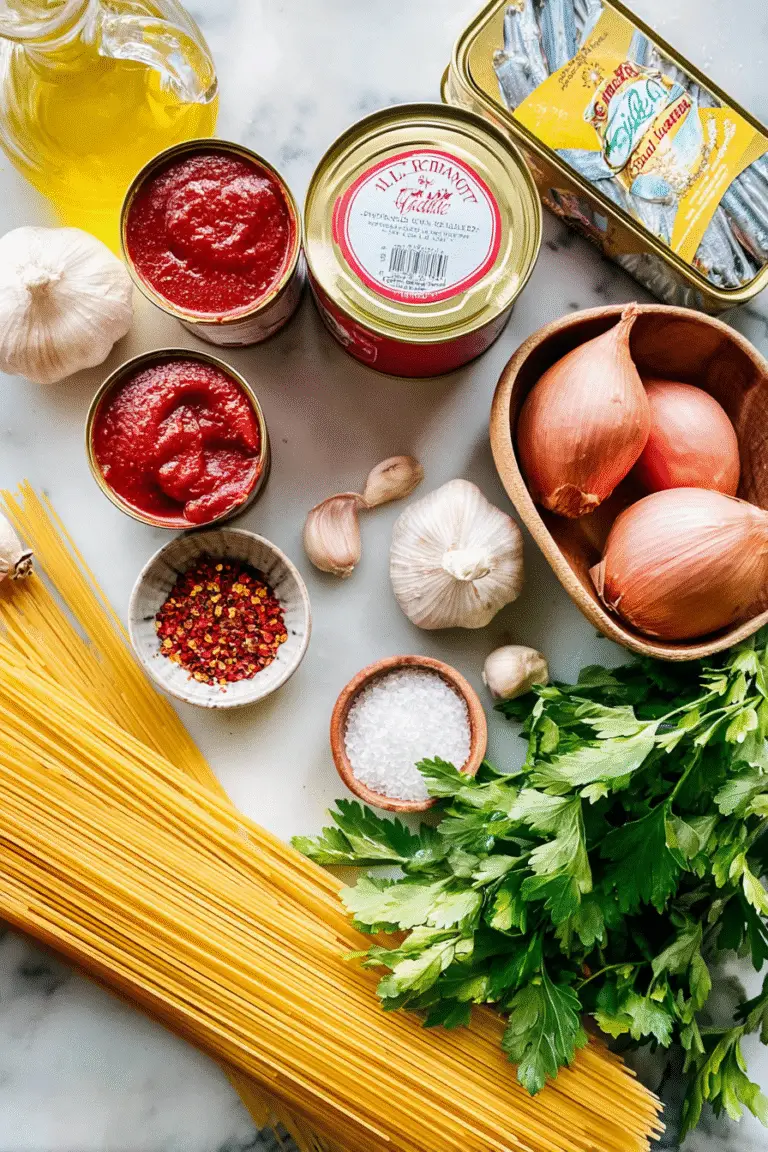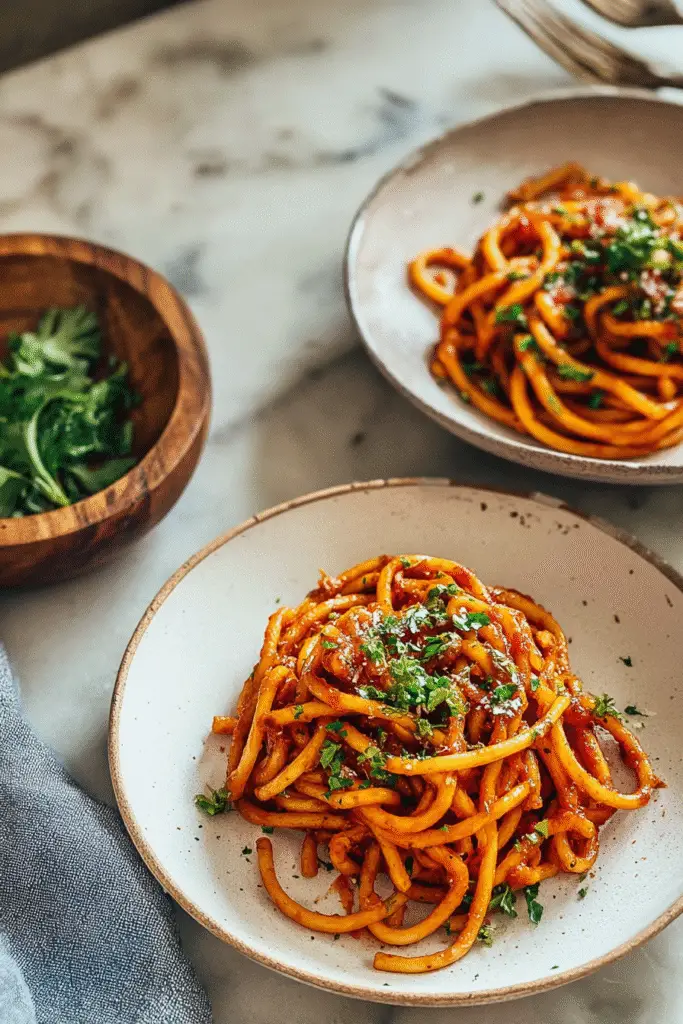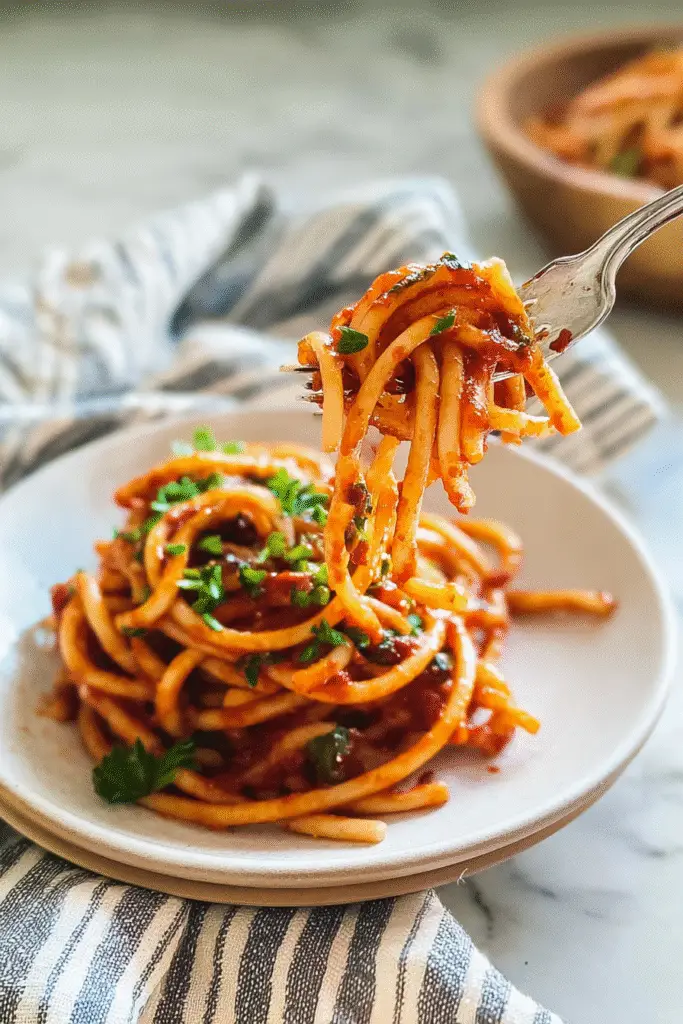The Origin and Viral Popularity of the Dish
This now-iconic dish originated from cookbook author and food writer Alison Roman, and skyrocketed into viral fame after being featured in the New York Times.
It gained traction on TikTok, Instagram, and YouTube due to its ease, pantry-only ingredient list, and big flavor payoff.
It became a quarantine comfort food for many—a simple yet rich pasta dish that felt like a warm hug in a bowl.
Print
What is Caramelized Shallot Pasta?
Silky tomato-shallot sauce clings to every strand of pasta, with a savory boost from anchovies, garlic, and chili flakes. It’s weeknight-easy, cozy, and restaurant-worthy. Make it tonight and rate the recipe ⭐⭐⭐⭐⭐ to help others find it!
- Total Time: 35 minutes
- Yield: 4
Ingredients
12 oz (340 g) bucatini or spaghetti
1 lb (450 g) shallots, thinly sliced
4 cloves garlic, finely minced
1 tsp red pepper flakes (reduce for mild)
4–6 anchovy fillets, chopped (optional but recommended)
6 oz (170 g) tomato paste
¼ cup (60 ml) extra-virgin olive oil
1 tsp kosher salt, plus more for pasta water
½ tsp freshly ground black pepper
1 cup (240 ml) reserved pasta water, as needed
1–2 tsp red wine vinegar or lemon juice, to finish
½ cup (25 g) chopped fresh parsley
½ cup (45 g) finely grated Parmesan (more for serving)
Instructions
Boil the pasta. Bring a large pot of salted water to a rolling boil. Cook pasta until al dente. Reserve 1–1½ cups pasta water and drain.
Caramelize the shallots. While pasta cooks, heat olive oil in a wide skillet over medium heat. Add shallots and ½ tsp salt. Cook, stirring often, until soft, jammy, and lightly caramelized, 10–12 minutes.
Build the flavor base. Stir in garlic, red pepper flakes, and anchovies. Cook 1 minute until fragrant and the anchovies melt into the oil.
Tomato paste time. Add tomato paste and cook 2–3 minutes, stirring, until it deepens to brick red and sizzles.
Make the sauce. Splash in ¾ cup reserved pasta water, scraping the pan to create a glossy, emulsified sauce. Season with remaining salt and pepper.
Toss the pasta. Add drained pasta to the skillet. Toss vigorously, adding more pasta water as needed until every strand is well coated and saucy.
Finish & serve. Off the heat, stir in vinegar/lemon juice, parsley, and Parmesan. Taste and adjust seasoning. Twirl into bowls and top with extra Parmesan and parsley.
Notes
Anchovy umami: They melt completely—no fishy taste, just depth. For vegetarian, skip anchovies and add 1 tbsp white miso for savory richness.
Shallot care: Slice evenly so they soften at the same rate; if they start to brown too quickly, reduce heat and add a splash of water.
Sauce sheen: Cook the tomato paste until it darkens—this step builds sweetness and complexity.
Make-ahead: Caramelized shallot sauce keeps 4 days refrigerated or 2 months frozen. Thin with pasta water when reheating.
Heat level: Adjust chili flakes to taste or add a knob of butter at the end to mellow the spice and add silkiness.
- Prep Time: 10 minutes
- Cook Time: 25 minutes
- Category: Dinner, Main Course
- Method: Stovetop
- Cuisine: Italian-Inspired
- Diet: Vegetarian
What Makes This Pasta So Addictive?
Let’s break it down. The star of the show, shallots, are slowly cooked in oil until they become caramelized and jammy. Add in a few anchovies (which melt into the oil for deep umami), tomato paste, red pepper flakes, and garlic, and you get a flavor base that’s bold yet balanced. Toss that with pasta and a bit of starchy water, and you’ve got magic.
Ingredients You’ll Need for Caramelized Shallot Pasta
Star Ingredient: Why Shallots Shine
Shallots are the heart of this dish. Think of them as the elegant cousin of the onion—milder, sweeter, and more complex. When slowly cooked, they caramelize into a soft, golden paste that creates the foundation of the sauce.
Unlike onions, shallots don’t overpower. They deepen in flavor as they cook, bringing a jammy, slightly tangy profile that balances beautifully with umami ingredients.
Use about 6 large shallots, thinly sliced. The thinner, the better for caramelizing evenly.
Supporting Cast: Anchovies, Tomato Paste, Garlic & More
Here’s what you’ll need to round out the flavor:
| Ingredient | Purpose |
|---|---|
| Anchovies (6) | Add deep umami, melt completely in oil |
| Tomato Paste (1/3 cup) | Adds tangy richness and color |
| Garlic (4–6 cloves) | Layers savory flavor beneath the shallots |
| Red Pepper Flakes (1 tsp) | Brings a warm heat |
| Olive Oil (½ cup) | Carries flavor and helps caramelize |
| Pasta (12 oz) | Spaghetti, bucatini, or linguine work best |
| Pasta Water (1 cup) | Binds sauce and creates creamy texture |
Anchovy-phobic? Don’t worry—they don’t taste fishy. They dissolve into the oil, leaving nothing but flavor.
Learn more about boosting flavor without dairy in our Honey Chicken – STAYS CRISPY for Hours!

Step-by-Step: How to Make Caramelized Shallot Pasta
How to Perfectly Caramelize Shallots
This step is slow—but so worth it. In a large skillet:
- Heat ½ cup olive oil over medium heat.
- Add thinly sliced shallots and cook slowly (about 15–20 minutes), stirring occasionally, until golden and soft.
- Add anchovies, garlic, and red pepper flakes. Cook until anchovies dissolve.
Patience here brings the sweetness and complexity that makes this pasta memorable.
Building the Flavor Base with Anchovy and Tomato Paste
Once the shallots and anchovies have melded:
- Stir in tomato paste and cook for another 2–3 minutes until dark red.
- It should begin to caramelize and stick slightly to the pan.
- Add a splash of pasta water to deglaze and loosen the mixture.
It should resemble a thick, rust-colored paste—rich, glossy, and ultra-fragrant.
Choosing the Right Pasta and Cooking it Perfectly
Best Pasta Types for This Recipe
You want noodles that hold onto the sauce, like:
- Bucatini (Alison’s choice)
- Spaghetti (classic and reliable)
- Fettuccine (for thicker bites)
- Gluten-free alternatives like brown rice pasta
Avoid small pastas—they won’t capture the luxurious coating of the shallot sauce as well.
Why Pasta Water is Essential for the Sauce
Don’t drain all your pasta water! That starchy liquid:
- Helps the sauce bind to noodles
- Adds creaminess without cream
- Enhances the glossy finish of the final dish
Reserve at least 1 cup before draining the pasta.
Check out this tip-packed Creamy Vegan Mushroom Pasta for another pasta recipe that relies on a silky, rich sauce.
Vegan and Gluten-Free Variations of the Recipe
Making it Vegan Without Losing Flavor
Anchovies bring umami, but you can swap them out. Try:
- Miso paste (1 tsp)
- Tamari or soy sauce (1–2 tsp)
- Nutritional yeast (sprinkle at the end)
- Capers or olives for briny depth
Make sure to use plant-based pasta and skip cheese if you garnish. The flavor is still deeply satisfying.
Gluten-Free Pasta Options That Work
This sauce pairs well with:
- Brown rice spaghetti
- Chickpea pasta
- Lentil pasta
Tip: Don’t overcook gluten-free pasta—it breaks down quickly. Undercook slightly, then finish in the sauce.
How to Store, Reheat, and Use Leftovers
Storing the Shallot Sauce Separately
You can make the shallot mixture ahead and store it for:
- Up to 1 week in the fridge
- 3 months in the freezer
Let it cool, then store in a sealed glass container. When ready to eat, reheat gently and toss with fresh pasta and hot pasta water.
Creative Uses for Leftover Sauce
It’s more versatile than you think. Try it:
- On toast with a fried egg
- Mixed into rice or couscous
- As a pizza base
- On roasted vegetables
- Swirled into soup
Make a double batch—you’ll thank yourself later.
Best Pairings and Serving Ideas
Side Dishes to Serve With Caramelized Shallot Pasta
Balance the richness with something light and bright:
- Arugula salad with lemon vinaigrette
- Steamed or grilled broccoli
- Roasted cherry tomatoes
- Garlic bread with olive oil (because carbs on carbs is always good)
Wine and Beverage Pairings
Try:
- White wine: Pinot Grigio, Sauvignon Blanc
- Red wine: Chianti or a light Merlot
- Non-alcoholic: Sparkling water with lemon or kombucha
Common Mistakes to Avoid
Overcooking Shallots or Pasta
Don’t rush the shallots—high heat will burn, not caramelize them. Keep it medium-low and stir often.
As for pasta, cook it 1 minute under al dente. You’ll finish it in the sauce so it absorbs flavor without getting mushy.
Using Too Much or Too Little Pasta Water
Too much = soup. Too little = sticky mess.
Start with ½ cup of pasta water. Stir and evaluate the texture. Add more only if needed to create that smooth, clingy sauce.
Don’t miss our One-Pot Lentil Pasta for another sauce that nails pasta water usage.
Why This Recipe is a Weeknight Winner
Prep Time vs. Flavor Payoff
This is what we call a lazy-gourmet meal. In just 30–35 minutes, you get:
- Sweet, rich shallots
- A silky, tomato-y, savory sauce
- A restaurant-level pasta dish with zero dairy
Perfect for weeknights when you want a cozy, satisfying meal without fuss.
Double Batches and Meal Prep Potential
Make extra shallot sauce and freeze it. You’ll always be 15 minutes away from dinner—just boil pasta and reheat.
FAQ Section: Caramelized Shallot Pasta Questions Answered
What makes caramelized shallot pasta taste so good?
The magic lies in slow-cooked shallots, anchovies, and tomato paste. Together, they build layers of sweet, salty, and umami flavors.
Can I make caramelized shallot pasta without anchovies?
Yes! Use miso paste, soy sauce, or capers for that salty punch. The flavor changes slightly, but it’s still amazing.
How long does it take to caramelize shallots properly?
Roughly 15–20 minutes on medium-low heat. Stir often and be patient.
Is this recipe spicy with red pepper flakes?
It has a mild heat. Adjust the amount to your preference—add more for a kick, or skip if you’re spice-sensitive.
Can I freeze caramelized shallot pasta sauce?
Absolutely. Store it in airtight containers and freeze for up to 3 months. Thaw and reheat with pasta water when ready.
What’s a good substitute for shallots?
Use yellow onions, sliced thinly. Add a pinch of sugar to mimic the natural sweetness of shallots.
Conclusion: Your New Favorite Pasta, Guaranteed
This caramelized shallot pasta recipe proves that pantry staples can deliver luxury in a bowl. Whether you’re hosting guests, meal-prepping, or just treating yourself to a rich, comforting dinner, this is a go-to worth memorizing.

